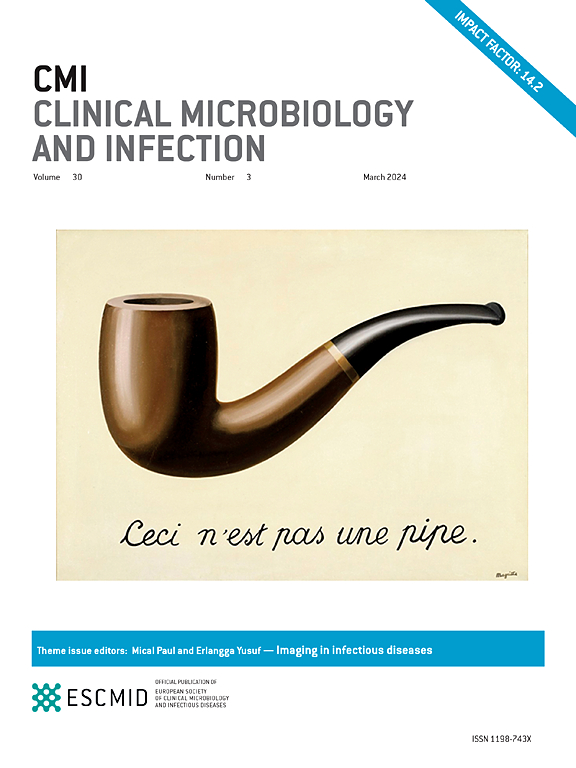青霉素治疗感染性心内膜炎的疗效。
IF 8.5
1区 医学
Q1 INFECTIOUS DISEASES
引用次数: 0
摘要
目的:青霉素常用于治疗感染性心内膜炎,特别是链球菌感染。本研究旨在进行青霉素的药代动力学/药效学分析,以评估不同病原体的目标达到概率(PTA)、最小抑制浓度(MIC)值、药代动力学/药效学目标和肾功能水平。方法:在部分口服心内膜炎治疗(POET)试验中,左侧感染性心内膜炎患者随机接受常规静脉注射或部分口服抗生素治疗。该亚研究包括静脉注射青霉素(3000 mg q6h)的患者。进行了药代动力学测量,并建立了群体药代动力学模型,通过基于模型的模拟来估计PTAs。药代动力学/药效学指标基于游离浓度(fT>MIC或fT>4xMIC)高于MIC(或4xMIC)的时间。结果:共纳入75例患者,获得291例血药浓度。68例患者的MIC值可用。50% fT>MIC和50% fT>4xMIC的个体目标完成率,链球菌为100%(56/56)和94.6%(53/56),葡萄球菌为100%(3/3),粪肠球菌仅为66.7%(6/9)和33.3%(3/9)。对于更严格的100% fT>MIC和100% fT>4xMIC目标,链球菌的个体目标完成率分别为89.3%(50/56)和75.0%(42/56),葡萄球菌的个体目标完成率分别为100.0%(3/3)和66.7%(2/3),而粪肠球菌的个体目标完成率分别为33.3%(3/9)和11.1%(1/9)。模拟结果表明,在50% fT>MIC目标下,MIC值≤0.5 mg/L,在50% fT>4xMIC或100% fT>MIC目标下,MIC值≤0.063 mg/L时,PTAs高于90%。较高的肾脏清除率与较低的pta相关。结论:在大多数感染性心内膜炎患者中,静脉注射青霉素达到了目标水平,特别是那些感染了链球菌或易感葡萄球菌的患者。然而,粪肠球菌患者个体目标达成率低,表明治疗肠球菌心内膜炎存在局限性,特别是对肾功能保留的患者。本文章由计算机程序翻译,如有差异,请以英文原文为准。
Target attainment of benzylpenicillin in patients with infective endocarditis
Objectives
Benzylpenicillin is commonly used to treat infective endocarditis, particularly for streptococcal infections. This study aimed to perform pharmacokinetic/pharmacodynamic analyses of benzylpenicillin to assess the probability of target attainment (PTA) across different pathogens, MIC values, pharmacokinetic/pharmacodynamic targets, and renal function levels.
Methods
In the Partial Oral Endocarditis Treatment trial, patients with left-sided infective endocarditis were randomly assigned to either conventional intravenous or partial oral antibiotic treatment. This substudy included patients receiving intravenous benzylpenicillin (3000 mg q6h). Pharmacokinetic measurements were conducted, and a population pharmacokinetic model was developed to estimate PTAs through model-based simulations. Pharmacokinetic/pharmacodynamic targets were based on time above MIC (or 4 × MIC) of the free concentration (fT > MIC or fT > 4 × MIC).
Results
A total of 75 patients were included, and 291 plasma concentrations were obtained. MIC values were available for 68 patients. Individual target attainment for 50% fT > MIC and 50% fT > 4 × MIC targets was 100% (56/56) and 94.6% (53/56) for streptococci, 100% (3/3) for staphylococci, but only 66.7% (6/9) and 33.3% (3/9) for Enterococcus faecalis. For more stringent targets of 100% fT > MIC and 100% fT > 4 × MIC, individual target attainment was 89.3% (50/56) and 75.0% (42/56) for streptococci, 100.0% (3/3) and 66.7% (2/3) for staphylococci, but 33.3% (3/9) and 11.1% (1/9) for E. faecalis. Simulations showed PTAs above 90% for MIC values ≤ 0.5 mg/L at the 50% fT > MIC target, and for MIC values ≤ 0.063 mg/L at 50% fT > 4 × MIC or 100% fT > MIC targets. Higher renal clearance was associated with substantially lower PTAs.
Discussion
Intravenous benzylpenicillin achieved target levels in most patients with infective endocarditis, particularly for those infected with streptococci or susceptible staphylococci. However, low individual target attainment in patients with E. faecalis suggests limitations in treating enterococcal endocarditis, especially in patients with preserved renal function.
求助全文
通过发布文献求助,成功后即可免费获取论文全文。
去求助
来源期刊
CiteScore
25.30
自引率
2.10%
发文量
441
审稿时长
2-4 weeks
期刊介绍:
Clinical Microbiology and Infection (CMI) is a monthly journal published by the European Society of Clinical Microbiology and Infectious Diseases. It focuses on peer-reviewed papers covering basic and applied research in microbiology, infectious diseases, virology, parasitology, immunology, and epidemiology as they relate to therapy and diagnostics.

 求助内容:
求助内容: 应助结果提醒方式:
应助结果提醒方式:


